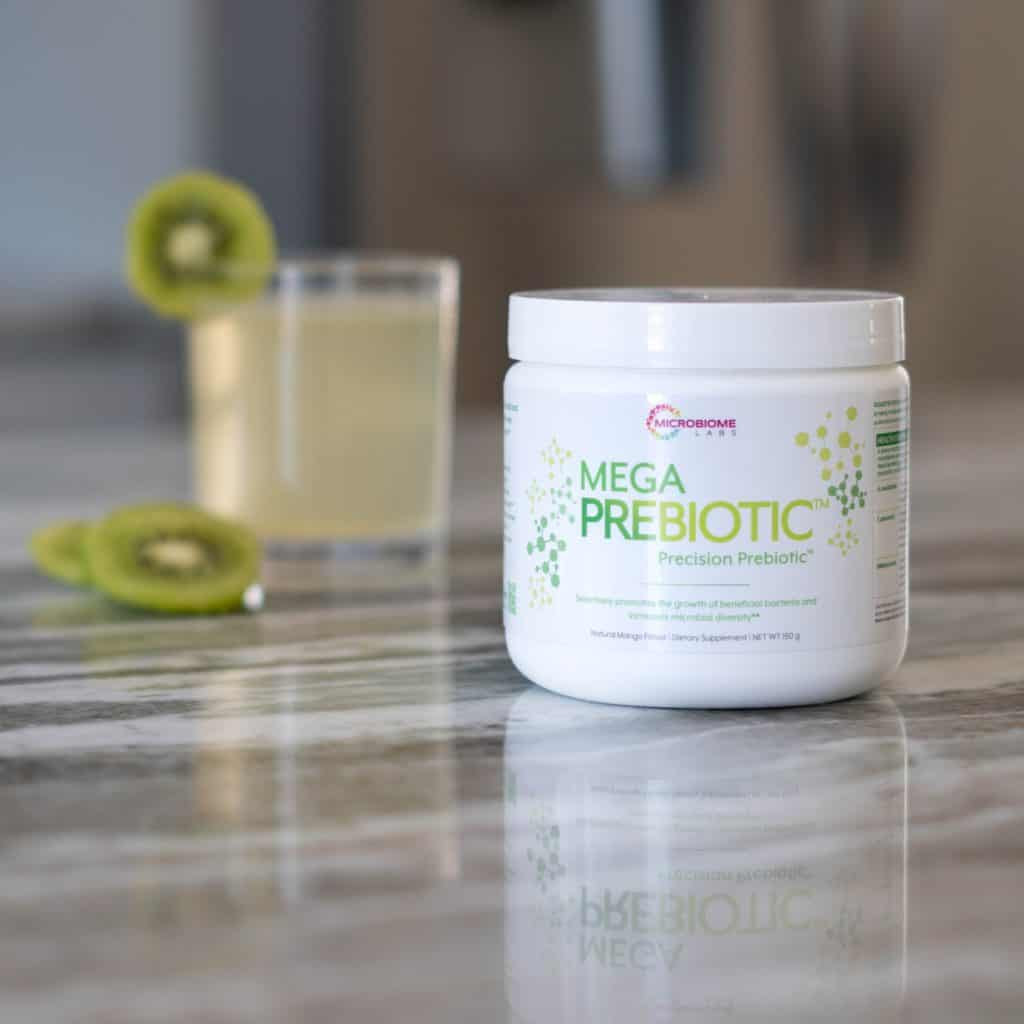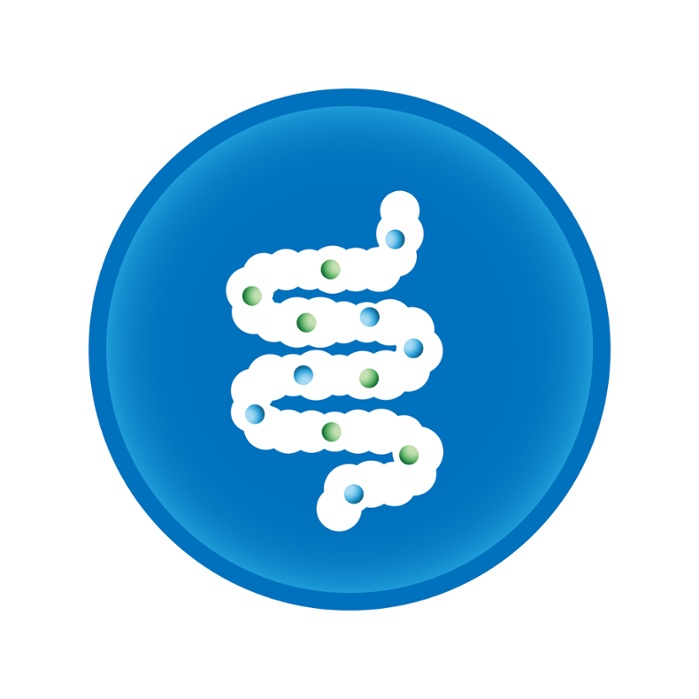Prebiotics are fibers, starches, saccharides, and polyphenols that promote the growth of bacteria in the gut.
We are unable to break down many of these components, and we depend on bacteria in our gut to do the job for us.
‘As our gut bacteria break down and ferment these fibers, they convert the fibers into healthy short-chain fatty acids and other metabolites that our body uses.
Prebiotics act as food for healthy microbes – and a steady supply of healthy prebiotics from food or supplements is necessary to maintain levels of bacteria in the gut.
Common prebiotics found in supplements include inulin, fructooligosaccharides, arabinogalactan, partially hydrolyzed guar gum, and others.
Insoluble fiber supplements, such as psyllium husk or senna, are inert in the gut and provide physical bulk and roughage to the stool that helps with motility. While motility is important, insoluble fiber supplements will not provide a feeding or prebiotic benefit to the gut microbiome.
So what’s the talk about precision prebiotics?
Many probiotics will feed good and bad bacteria alike. Their selectivity is imprecise.
If an imbalance is present, taking prebiotics too early in a protocol can cause a setback in symptoms – especially if the prebiotics are broad-spectrum.
For instance, Lactobacilli are generally healthy groups of bacteria for the gut.
When overgrown, however, Lactobacilli can cause problems. Because the majority of Lactobacilli live in the small intestine, an overgrowth of Lactobacilli can lead to symptoms of small intestinal bacterial overgrowth (SIBO) which can include bloating, gas, distention, discomfort, alternating constipation and diarrhea, as well as symptoms outside of the intestines such as mental fog, flare-ups in immune symptoms, or fatigue.
Their overgrowth can lead to pH changes in the intestinal environment that invites the growth of potentially pathogenic bacteria.
If you take a Lactobacilli-containing probiotic, or an imprecise prebiotic blend – it will work to potentiate an overgrowth and symptoms can remain or even worsen.
For many years, it was difficult to know how you might respond until you started taking a new probiotic or prebiotic. For many – it helped, but for others the wrong product lead to a rebound in bloating and gastrointestinal discomfort.
The guesswork is changing, as a new group of precision prebiotics are finding their way onto the supplement market.
Precision prebiotics contain specific fibers that selectively feed groups of gut microbes established to be important components of a healthy gut.
The gut contains trillions of microorganisms. We have learned that humans are more bacteria than “human”, as microbe numbers outnumber the cells in our body by ten to one! Even the most conservative critics accept that there are 1.3 microbe cells to every human cell (1).
The body has learned to live long and prosper with our friendly gut inhabitants. As long as we provide a healthy home for our microbes – they give us benefits in return.
They help stimulate and balance our immune system, they crowd out pathogens, they produce antioxidants, and they produce other nutrients.
Our gut microbes produce so many byproducts that scientists will have a lifetime of research ahead of themselves to discover all of the roles they play in our physiology. These byproducts as a whole are known as the “metabolome”.
With loss of bacteria diversity comes a loss of the metabolome diversity – which means we’re less equipped to deal with the moment-to-moment changes of life. This leads to excess oxidative stress, inflammation, weight gain, immune imbalance, and can even affect mental health.
The gut houses the vast majority of bacteria, and it’s somewhat of a seeding ground for the rest of the body.
I’ve written extensively on taking probiotics – and have a number of resources for those looking for quality probiotics, those trying to recover from antibiotic treatment, or those looking for general guidance on which probiotics to start with.
Maintaining a healthy balance of gut microbes sooner or later comes back to consuming enough quantity and diversity of prebiotics from food and supplements.
Introducing Precision Prebiotics
 The first precision prebiotic to show up on the market was MegaPrebiotic by Microbiome Labs. It contains galactosaccharides, oligosaccharides and xylosaccharides.
The first precision prebiotic to show up on the market was MegaPrebiotic by Microbiome Labs. It contains galactosaccharides, oligosaccharides and xylosaccharides.
Our body does not have a natural ability to breakdown the certain saccharides found in food, but some bacteria can.
The specific collection of saccharides in MegaPrebiotic make their way to the colon where they selectively promote key large intestine microbes including Bifidobacteria, Akkermansia muciniphila and Faecalbacterium prauznitzii.
The selective promotion of beneficial strains is why MegaPrebiotic is referred to as the first precision prebiotic.
The prebiotic benefits of the individual galactosaccharides, oligosaccharides, and xylosaccharides have been detailed by previous 3rd party publications (2; 3; 4).
Microbiome Labs commissioned a study that was published in the International Journal of Pharmaceutics. The study demonstrated that the combination of the prebiotic saccharides enhanced Bifidobacterium spp, Akkermansia muciniphila, and Faecalbacterium prauznitzii levels when combined with their flagship product – Megasporebiotic.
The Megaprebiotic study also demonstrated the ability of the two products to increase short chain fatty acid (SCFAs: Butyrate, proprionate, acetate) production by 80-140%!
With any probiotic or prebiotic, it’s important to start low and work your way up. Any sudden change to the microbiome, good or bad, can lead to symptom changes if a product is integrated too fast.
Megaprebiotic Protocol:
Week 1: One 1/2 scoop daily to 16oz water for 1 week.
Week 2+: One full scoop in 16oz of water daily.
Other prebiotics can certainly be healthy additions – just better tolerated much later in a recovery protocol and used more for wellness purposes than initial “recovery” purposes.
This is because other, less precise prebiotics feed a wider range of bacteria – some of which may be overgrown in the small intestine.
If you still have trouble tolerating a product, we generally recommend taking a step back to work on inflammation, clearing overgrowth of bacteria or fungi, adding probiotics, or addressing issues with motility.
I’ve detailed these phases more explicitly in The 7 Core Strategies to Heal the Gut Lining and Manage Leaky Gut Naturally.
Polyphenols are chemicals in brightly colored fruits and vegetables that also show unique and selective abilities to support a healthy microbiome with antioxidant, anti-inflammatory, nutritive, and prebiotic benefits.
For now, when first trying prebiotics, I recommend starting with ingredients like those found in MegaPrebiotic, and waiting to introduce other prebiotics like PHGG in Trufiber, or a broad-spectrum blend such as Biotagen by Klaire Labs.
Polyphenols are plant chemicals that have now also been shown to provide prebiotic benefits. MegaMucosa and MegaGuard contain polyphenol compounds that support inflammation, mucosal health, as well as microbiome diversity.
Long-term, the goal is to consume a variety of fibers and polyphenols in your diet, and supplementally you can mix and match prebiotic formulas to keep your system guessing long-term.
With a precision prebiotic like Megaprebiotic, you can more confidently introduce prebiotics into your protocol – and provide a convenient bridge to more broad-spectrum prebiotics in food and supplements.
Megaprebiotic is part of Microbiome Labs’ Total Gut Restoration protocol.
Enter your information below for instant access to the program details as well as a welcome offer for Megaprebiotic, Megasporebiotic, as well as MegaMucosa.





